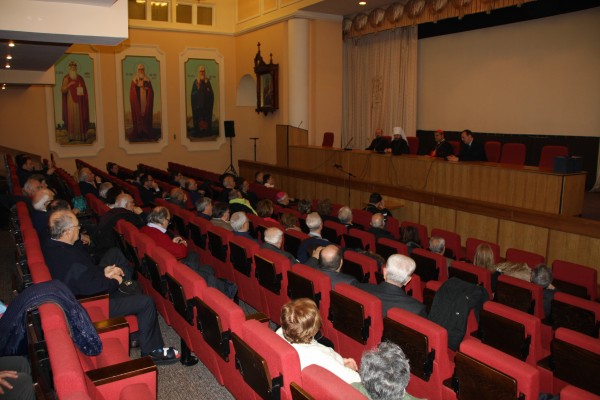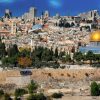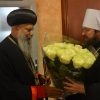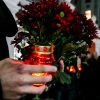The pilgrims were accompanied by Prof. Adriano Roccucci, general secretary of the Community of St. Egidio, and Archpriest Igor Vyzhanov, rector of St. Andrew’s in Naples.
Having greeted the guests with the traditional Easter exclamation: “Christ is risen!” Metropolitan Hilarion welcomed the guests, saying that it was a good time for their pilgrimage “because this year we celebrate Pascha at the same time”.
Metropolitan Hilarion spoke about the intensive regeneration that took place in the Russian Church for the last 25 years. “Last year we celebrated the 1025th anniversary of the Baptism of Rus’ and summed up the achievements we had made during those years since the Millennium of Rus’ in 1988. The Millennial celebrations were a kind of turning point as before them our Church had been persecuted by the state for 70 years. In the 20s and 30s the persecution was very severe and bloody: most of our clergy, episcopate and monastics were simply annihilated physically; all the monasteries, all the theological schools and almost all the churches were closed, many of them destroyed. During the war and in the post-war time the state allowed the Church to revive its structure to a degree, but in the 60s a new wave of persecution started to continue with lesser or greater intensity till the late 80s.
“When the church began preparing the Millennium celebrations, the authorities warned us that it should be a narrow ecclesial event not going beyond churches and monasteries. The celebrations coincided with changes in the life of the country, which made it possible for people to express their beliefs more openly. It was the time of a high point in the so-called “policy of glasnost” under Gorbachev. Thousands, tens of thousands and hundreds of thousands of people took to streets, marching in processions with the cross to show their commitment to Orthodox faith.
“His Holiness Patriarch Kirill was Archbishop of Smolensk and Vyazma at that time. He proposed to arrange celebrations at the local stadium of his city with the population of 60 thousand and asked the governor’s permission. The reply was: “What do you need a stadium for? You will not be able to assemble even a thousand people”. When forty thousand people came out for a procession with the cross, that is, two thirds of Vyazma’s population, it was a great surprise for the city authorities.
“The same happened in almost all the cities. Since that moment, the authorities realised that they had to give freedom to the Church. Thus the church renewal started to continue ever since.
For the twenty five years, 25 thousand churches were restored or built anew. It means that each year we opened a thousand churches, three churches a day. We had twenty monasteries and now there are over 800, with all of them filled with monks and nuns, most of them young. We had three theological seminaries and two theological academies. Now there are over 100 educational institutions. This simple statistics points to an absolutely unprecedented nature and scale of the regeneration experienced by the Russian Church. May be, something similar took place in the Roman Empire in the 4th century after the Edict of Milan was issued, but there is no statistics about that time, but it is available in our time. The point is that tens of millions of people have found faith in the post-Soviet time.
“Much was done for the renewal of the Church under Patriarch Alexy II. Along with the restoration of church structures, the Church managed to preserve her unity. Being multinational, the Russian Orthodox Church exercised jurisdiction not only over Russia but fifteen states including thirteen former republics of the Soviet Union, as well as Japan and China. It is a vast territory, which saw, especially in the 90s, political developments that divided the space into many newly-established states. The new political borders went not only along rivers, lands and lakes but through people’s lives, dividing families, when members of the same family found themselves living on opposite sides of the border. All this was often accompanied with bloody armed conflicts. It was a time of severe depression for people, exacerbated by an economic crisis. The Church came to face a difficult task to preserve her unity in spite of the centrifugal political processes. It was especially important because the Church had to give people spiritual and moral support.
“Regrettably, in the early 90s, Ukraine saw a schism when the then president together with the then Metropolitan of Kiev added to their armoury the principle of “an independent Church in an independent state”. They managed to separate some of the people and clergy from the Church and then, with the help of the then president, to obtain church buildings for their newly created structure. Thus, this schismatic structure began swelling. The situation of divided Orthodoxy in Ukraine does not contribute to the unity of the Ukrainian people, nor do the processes taking place today in that country, because both internal and external forces seek to pull Ukraine apart. From the very beginning of political confrontation, the schismatics fully identified with one of its sides. Regrettably, the Greek Catholics did the same: they identified with a certain political force and entered in full alliance with the schismatics. It was for us a very unpleasant and bitter surprise.
“Regrettably, the whole history of Uniatism has been filled with this kind of “surprises” with regard to the Orthodox. Uniatism was created at an era when the Orthodox and the Catholics were in a state of war. It was created with a very simple and plain aim: to convert the Orthodox into Catholicism. We have fully overcome this mentality of rivalry and enmity in the bilateral relations with the Roman Catholic Church, as the Orthodox and the Catholics today do not view each other as rivals but as allies. We have many tasks in common. There is a great deal of challenges before us, and we are doing much to tackle problems together. But, unfortunately, the Greek Catholics do not participate in our rapprochement and continue to live by stereotypes of the past. Today their activities, openly hostile to the Orthodox Church, continually throws us back while we want to go forward.
“For the last years, we have made many achievements in our dialogue with the Roman Catholic Church. With regard to the theological dialogue, in which all the Orthodox Churches participate, I think, it made an important achievement in our common condemnation of unia in the 1993 Balamand Document. In this historical document, the both sides, Orthodox and Catholic, admitted together that unia is not a way of achieving unity. At least on the theoretical level we have come to full unity and mutual understanding on this issue. Now, it would be important, of course, to transfer the achievements in theory to practice.
“I would also like to note that the Russian Orthodox Church has established very constructive and good multi-level relations with the Roman Catholic Church. My predecessor as head of the Department for External Church Relation and now His Holiness Patriarch of Moscow and All Russia has met with Pontiffs of Rome on many occasions, with Pope John Paul II and Pope Benedict XVI. For the five years that I have headed our Church’s “ministry for foreign affairs”, I have had five meetings with Pontiffs of Rome, three with Pope Benedict XVI and two with Pope Francis. Every time I noted a very high level of the pontiff’s awareness of all the problems encountered in the Orthodox-Catholic dialogue and cooperation.
Among the main areas of our cooperation today, in my view, should be the protection of Christians who are subjected to persecution in various parts of the world. Regrettably, we have become today witnesses to the persecution, unprecedented in its scale, against those who believe in Christ in the Middle East, North Africa and a number of other regions of the world. Millions of Christians have fled the countries in which they lived for almost two millennia. Now the very survival of Christianity in the Middle East is challenged; for in such countries as Libya, Pakistan and Afghanistan it has almost vanished. In the last ten years in Iraq, the number of Christians has decreased ten times. There is a mass exodus of Christians from Egypt. Christian communities in Syria have found themselves in a grave situation in places captured by militants. We receive almost daily reports about the suffering of Christians, about the kidnapping of Christian clergy, execution of Christian believers by shooting or beheading. We are grateful to Pope Francis for his very consistent stand on this problem, which coincides with our position.
“On September 5, 2013, when President Vladimir Putin hosted the G-20, Pope Francis of Rome sent him a letter asking him to use all his authority to stop the hostilities in Syria. Very active and intensive actions are needed to influence the international situation. I trust that our cooperation in this area will bring forth fruits.
“I would like to note that we have established very good and very fruitful relations with the Roman Catholic structures in Italy. For the last 20 years, a great number of our compatriots have found themselves in Italy, among them Moldavians, Ukrainians, Russians and people of other nationalities. To provide them with pastoral care, we have established parishes there, which are about sixty now. They are opened not for the sake of proselytism but with the aim to provide pastoral care for those of our compatriots who have found themselves in Italy for various reasons, and we are grateful to the hierarchs of the Roman Catholic Church who have given us buildings to use so that we could set up our parishes in them.
In 2007, you, Your Eminence, gave to the Russian Church a church with parish facilities for free usage, in Naples. Thanks to you help, we have managed to arrange pastoral care for our compatriots in your city. Father Igor Vyzhanov here, a former staff member of the Department for External Church Relations, is rector of St. Andrew’s in Naples.
“I would like to wish you, Your Eminence, God’s help in your important ministry and to all the pilgrims – a blessed visit to our Russian Church”.
Speaking on behalf of the pilgrims’ group, Cardinal Sepe thanked Metropolitan Hilarion for the warm welcome and the talk.
Metropolitan Hilarion answered questions from the guests about the number of believers of the Russian Orthodox Church, the educational reform in the Russian Church, church-state relations and the schism in Ukraine as a possible consequence of the present political crisis in the country.

















